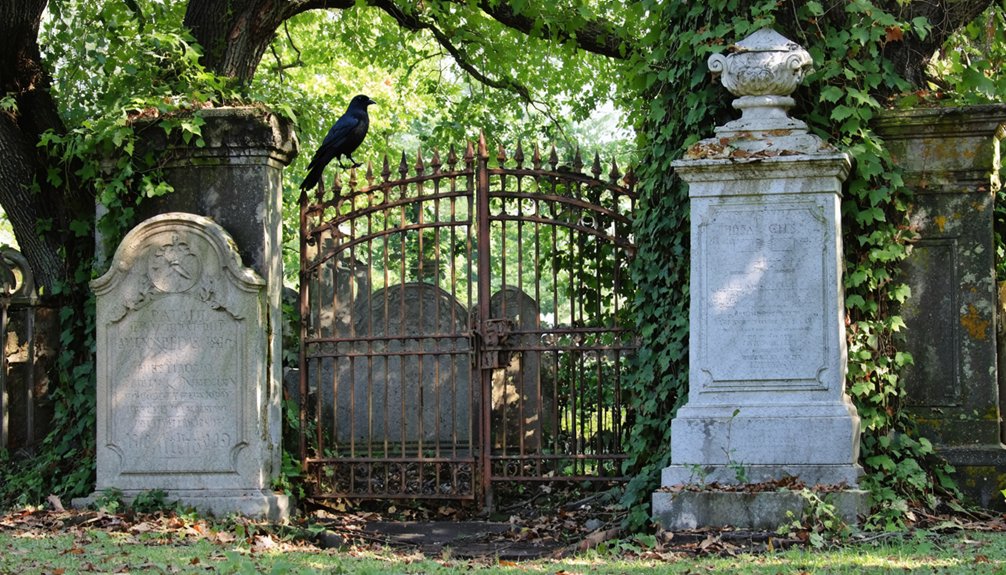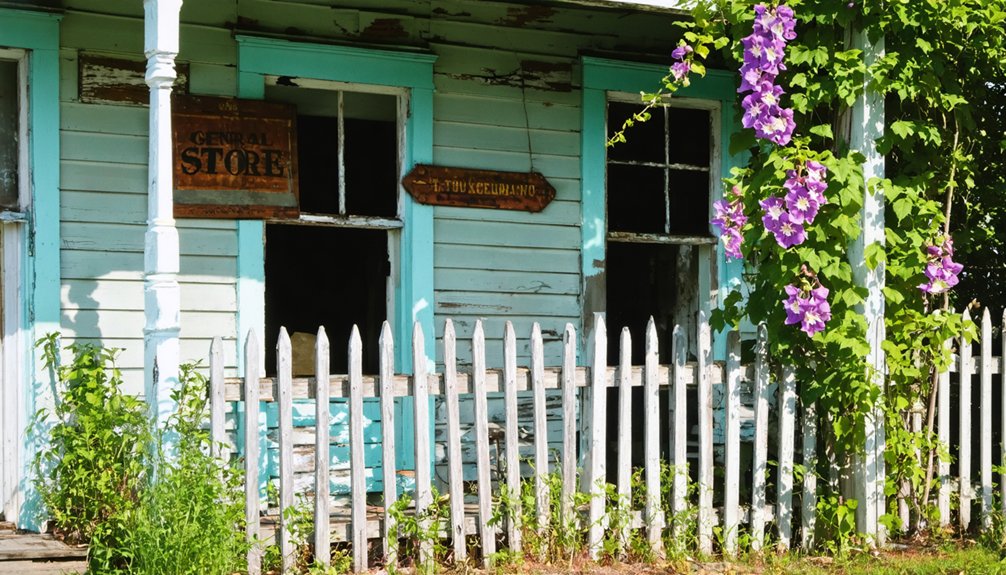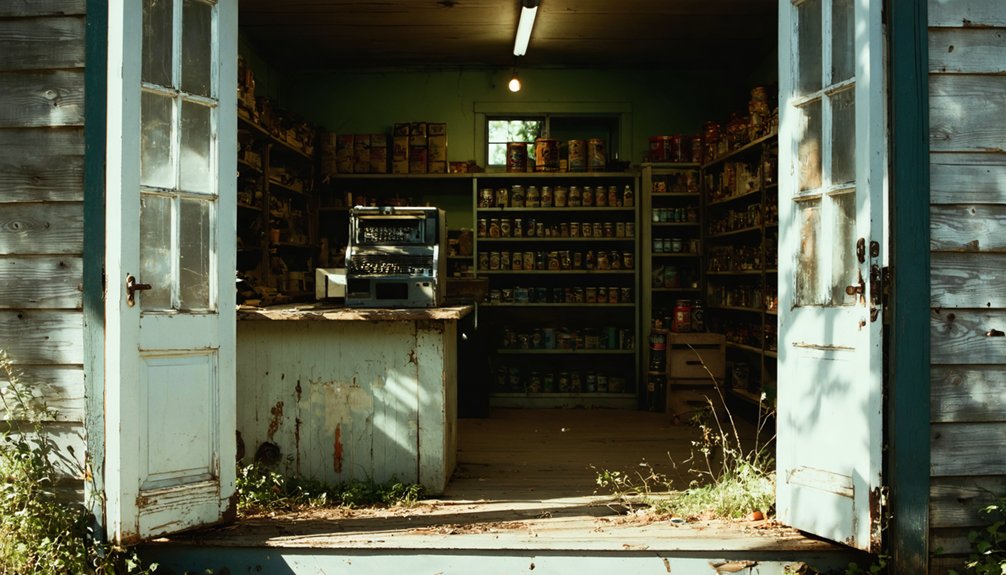You’ll find the ghost town of New Market at the intersection of Holly Tree Road and Reynolds Pond Road in Sussex County, Delaware. This 18th-century settlement, once anchored by the Wesley Methodist Episcopal Church (1810), thrived as a small farming community between Ellendale and Milton. Today, only the New Market Cemetery remains, with weathered headstones dating to the 1800s. The site’s rich history of religious fervor, agriculture, and community life holds many untold stories.
Key Takeaways
- New Market was an 18th-century settlement in Sussex County, Delaware, located between Ellendale and Milton at Holly Tree and Reynolds Pond Roads.
- The Wesley Methodist Episcopal Church, established in 1810, served as the community’s focal point until its eventual abandonment.
- Only the New Market Cemetery remains today, featuring weathered headstones from the early 1800s among overgrown grass.
- The ghost town’s location is now marked by modern developments, including the New Market Village Mobile Home Park nearby.
- The settlement’s history is poorly documented, with no historical markers and limited records consisting mainly of scattered local history mentions.
Origins and Early Settlement
Located between Ellendale and Milton in Sussex County, Delaware, New Market emerged as a small settlement in the 18th century.
You’ll find its original location near the intersection of Holly Tree Road and Reynolds Pond Road, where settlement patterns centered around a church and a close-knit community.
Like many Delaware towns of that era, New Market’s establishment reflected the region’s agricultural practices, with families settling in the area to farm the coastal plains. Similar to the trade networks established by Native Americans before European settlement, the community developed its own local trading relationships.
The establishment of the Wesley Methodist Episcopal Church in 1810 marked a significant milestone in the town’s development.
While the exact founding date isn’t recorded, the town developed similarly to its neighbor Milton, growing organically around essential community structures.
The landscape’s rural character supported the town’s modest development, though it never grew into a large population center.
Today’s residential developments have largely obscured the original town’s footprint.
The New Market Church Legacy
Though New Market’s broader community has faded into history, its Methodist Episcopal Church stands as the town’s most enduring legacy.
You’ll find the church’s Methodist influence reflected in its multiple expansions, with rebuilds in 1850 and 1881 showcasing the congregation’s growth and significance. The religious practices here were distinctly energetic – they were known as “shouting Methodists,” setting them apart from other, more reserved congregations in the region. Like First Baptist Church, New Market’s church started with services in private homes before constructing its permanent building.
You can trace the church’s commitment to its community through its cemetery expansions in 1858 and 1903. Established on Elias Lofland’s donated land near Prime Hook Creek, the church became a cornerstone of local religious life, embodying the broader Methodist Episcopal movement that shaped Delaware’s spiritual landscape throughout the 19th century. This religious heritage connects to Delaware’s rich history of African American church development, including the Union Church of Africans founded in 1813.
Life in 18th Century Rural Delaware
You’d find daily farm life in 18th century rural Delaware centered around wheat cultivation, livestock care, and essential household activities like candle-making and textile production.
Your typical day would involve working alongside family members, paid servants, or enslaved laborers to manage crops and tend to animals on small tenant farms or modest properties.
While religious gatherings brought the dispersed farming community together, you’d share social and economic connections through local trade networks stretching along the Delaware River to Philadelphia. Local merchants often shipped the area’s grain and flour to lucrative markets in the West Indies.
Archaeological evidence shows that both ordinary property owners and poor tenants gradually adopted tea drinking practices as part of their social routines.
Daily Farm Life
Life on an 18th-century Delaware farm revolved around strict gender roles and daily routines that sustained both family and livelihood.
You’d find men working the fields – plowing, sowing, and harvesting – while women managed the household and performed essential farm chores like milking cows and tending animals.
As a woman, you’d rise before dawn to begin your twice-daily milking, balance heavy yokes of water, and oversee your children’s farm education.
The family worked together as one productive unit, ensuring the farm’s successful operation through shared labor and responsibilities.
Your daily tasks would vary by season.
In spring, you’d plant kitchen gardens, assist with calving, and gather medicinal plants.
Summer brought harvesting, while fall meant storing grain in barn bays.
Winter wasn’t idle – you’d continue indoor work like spinning and sewing, while men threshed grain with flails in the barn.
With high infant mortality rates in the 1700s, mothers typically bore up to eight children to ensure family survival.
Religious Community Gatherings
While no single faith dominated 18th-century rural Delaware, religious gatherings formed the backbone of community life. You’d find Lutherans, Dutch Reformed, English Quakers, Welsh Baptists, and Catholics coming together in a unique voluntary church system.
Before formal buildings existed, you’d attend services in neighbors’ homes, where community rituals strengthened social bonds beyond religious practice. The Delaware Indians maintained their traditional matrilineal clan system while participating in these interfaith exchanges.
Interfaith gatherings weren’t uncommon in this pluralistic environment. You might witness Moravian missionaries fostering relationships with Delaware Indians, while Quakers advocated for peace and equality. Early Friends meeting houses appeared around 1687, establishing permanent places of worship.
Each group brought distinct worship styles, from the silent meditation of Quakers to the structured services of Lutherans. This religious diversity reflected Delaware’s position between northern European Protestant traditions and southern influences, creating a remarkably tolerant society.
Geographic Location and Surroundings
If you’re looking for New Market’s exact location in Sussex County, Delaware, you’ll find this ghost town at the intersection of Holly Tree Road and Reynolds Pond Road, nestled in the rural landscape between Ellendale and Milton.
The settlement once occupied the flat, agricultural terrain typical of Delaware’s coastal plain, with Reynolds Pond serving as a prominent nearby water feature.
You can still trace the town’s historical footprint at this crossroads, though today the site has largely returned to its rural character, surrounded by farmland and patches of forest.
Rural Sussex County Setting
Nestled between the Delaware towns of Ellendale and Milton in eastern Sussex County, New Market’s ghost town site occupies a quiet stretch of rural landscape at 38°48′26″N 75°23′49″W.
You’ll find the area’s rural traditions preserved in the surrounding patchwork of deciduous forests, pine woodlands, and active farmland that characterizes the region’s agricultural practices.
While the original town has vanished, New Market Village Mobile Home Park now stands a quarter mile east of the former settlement, positioned along the banks of the Broadkill River.
The area’s flat to gently rolling Coastal Plain terrain supports scattered ranch-style homes amid expansive croplands and pastures.
Despite modern development, you’ll experience the authentic charm of Delaware’s agricultural belt, where forests and farms dominate the landscape rather than urban sprawl.
Historical Crossroads Location
Situated at the intersection of Holly Tree Road and Reynolds Pond Road, the historic crossroads of New Market anchored a once-thriving rural community just east of Ellendale.
Located at 38.80722°N latitude and 75.39694°W longitude in Sussex County, Delaware, this crossroads served as the heart of local community gatherings since the 18th century.
The site’s crossroads significance peaked around 1810 with the establishment of New Market Church, which became the focal point of rural life.
While you won’t find the original village structures today, the church cemetery remains as a symbol of the crossroads’ historical importance.
The surrounding landscape retains its rural character, with scattered farmland and residential developments replacing what was once a vibrant meeting place for local residents.
Between Ellendale and Milton
The rural ghost town of New Market lies one mile east of Ellendale along Reynolds Pond Road in Sussex County, Delaware.
You’ll find this vanished settlement at the intersection of Holly Tree Road, positioned strategically between the towns of Ellendale and Milton. The area’s settlement patterns reflect its agricultural heritage, with scattered farms and woodlands dotting the flat landscape typical of central Sussex County.
Today, you’ll discover only a small cemetery marking where the New Market Church once stood.
While the original settlement’s structures have disappeared, the surrounding region maintains its rural character through small-scale farming practices. A modern mobile home park called New Market Village stands as the only namesake development, situated a quarter mile east of this historic crossroads.
Lost Structures and Remaining Traces
While New Market’s original village structures have largely vanished from Delaware’s landscape, a small cemetery at Reynolds Pond Road and Holly Tree Road marks where the town’s centerpiece – New Market Church – once stood.
This lost architecture reflects a bygone era of community memory, preserved mainly through early 20th-century photographs and scattered historical records.
- A stone marker within the cemetery commemorates the church’s location, established around 1810.
- The Milton Historical Society holds photographs from 1908 and 1920 showing the church and cemetery.
- No visible ruins remain of other village structures like stores or schools.
- A modern mobile home community called New Market Village now stands east of the original crossroads, preserving only the historic name.
The Historic Cemetery Today

You’ll find New Market Cemetery standing as the last tangible remnant of this ghost town at the intersection of Holly Tree and Reynolds Pond Roads, where weathered headstones bearing willow tree engravings mark graves dating back to the early 1800s.
While the cemetery contains at least 140 documented burials, its preservation status has declined considerably since the last interment in 1959, with many markers now toppled or illegible from exposure to the elements.
The site’s historic markers reveal the socioeconomic diversity of New Market’s former residents through varying gravestone materials and craftsmanship, though these invaluable artifacts face ongoing deterioration without a formal preservation program in place.
Cemetery Layout Features
Located at the intersection of Holly Tree Road and Reynolds Pond Road, New Market Cemetery occupies the former churchyard of New Market Church, which stood until 1953.
You’ll find a variety of grave marker shapes throughout the informal layout, from rectangular slabs to rounded-top tablets, many featuring classical cemetery symbolism like willow tree engravings that represent mourning.
- The cemetery contains 140-169 recorded memorials spanning from the late 18th to mid-20th century.
- There aren’t any formal pathways or sections dividing the grounds.
- Family plots exist but lack clear boundary markers.
- Graves are scattered across the property with some family clustering evident.
The cemetery’s layout reflects its origins as a small, rural 18th-19th century churchyard, serving as the last remaining landmark of the original New Market settlement.
Preservation Status Updates
Today’s New Market Cemetery faces significant preservation challenges, with overgrown grass and deteriorating headstones highlighting years of limited maintenance.
You’ll find approximately 140 documented graves here, though many more remain undocumented. The cemetery’s upkeep largely depends on volunteer boards and community donations, as there’s no dedicated state funding for its preservation.
The cemetery maintenance situation reflects broader funding challenges across Delaware’s historic burial grounds.
While the Delaware Cemetery Board, established in 2009, oversees distressed cemeteries, it can’t provide extensive care. Local preservation groups actively seek grants and donations, but competition for resources remains fierce.
Many headstones continue deteriorating, with some becoming illegible or toppled due to weathering and neglect.
Notable Historic Markers
The historic marker at New Market Cemetery stands as a humble stone monument, commemorating the former New Market Church that was organized in 1810 and removed in 1953.
You’ll find this marker along Reynolds Pond Road, representing the community’s heritage at the site where a vibrant settlement once thrived.
- The stone marker, while not an official Delaware State Historical Marker, serves as the primary identifier of this historic significance.
- You’ll discover 169 memorial records within the cemetery grounds, documenting the area’s earliest residents.
- The marker’s presence helps preserve the memory of this ghost town that never achieved the growth of neighboring communities.
- Historic photographs from 1908 and 1920, preserved by Milton Historical Society, complement the marker’s representation of New Market’s past.
Community and Social Life

During its prime in the late 19th century, New Market’s social fabric centered heavily around the New Market Church, where residents practiced a distinctive form of “shouting Methodism” that set them apart from neighboring communities.
This fervent worship style fostered strong social cohesion among townspeople, with regular community gatherings reinforcing their shared identity.
Though never heavily populated, you’d find residents maintaining active social connections through local establishments like the town store and blacksmith shop.
As the town faced economic pressures, people increasingly relied on nearby Milton and Ellendale for commerce and services.
While this outward migration eventually contributed to New Market’s decline, residents preserved their social bonds through church activities and regional networks well into the early 20th century, even as their numbers dwindled.
From Village to Ghost Town
Once thriving as a modest crossroads settlement between Ellendale and Milton, New Market’s transformation into a ghost town unfolded gradually through the 19th and early 20th centuries.
The community dynamics shifted as larger nearby towns drew residents away, while the lack of economic development prevented sustainable growth.
Like many rural hamlets, New Market withered as its population drifted toward bustling economic centers offering greater opportunities.
- You’ll find the original village site has completely vanished, with only the church cemetery remaining as evidence to its historical significance.
- The settlement’s decline left no surviving structures beyond the cemetery that marked the former church location.
- Today’s New Market Village Mobile Home Park, though bearing the town’s name, stands separate from the original settlement.
- The village’s memory persists primarily through archival records and local oral histories, without even a state historical marker to commemorate its existence.
Historical Documentation and Records

Piecing together New Market’s history presents unique challenges for modern researchers, as surviving documentation remains remarkably scarce.
You won’t find an official Delaware State Historical Marker at the site, and the available records are limited to scattered mentions in local histories and vintage postcards.
The most tangible evidence of the town’s historical significance lies in a solitary stone marker at the Reynolds Pond Road cemetery, indicating where New Market Church once stood.
Research challenges abound, as no detailed census records or town ledgers have survived in public archives.
The state and county historical societies maintain only sparse references to this vanished community, making it difficult for you to construct a thorough picture of life in early New Market.
Modern Remnants and Memory
Today at the crossroads of Holly Tree Road and Reynolds Pond Road east of Ellendale, you’ll find scant evidence that New Market ever existed. The once-vibrant community’s physical presence has largely vanished, replaced by scattered ranch homes and a trailer park that bears the old town’s name.
Community identity has faded as thoroughly as the buildings themselves, with no organized efforts at memory preservation in place.
Like mist fading into morning air, New Market’s community spirit has dissolved, leaving no organized attempt to preserve its memory.
- The historic church cemetery remains the sole tangible link to New Market’s past
- New Market Village trailer park serves as the only modern namesake
- No historic markers, plaques, or memorials commemorate the former settlement
- Local knowledge of the town’s history is limited to enthusiasts and historians
The landscape you’ll see today reflects decades of rural transformation, with modern development obscuring nearly all traces of the original settlement.
Frequently Asked Questions
Are There Any Ghost Stories or Paranormal Activities Reported at New Market?
You won’t find documented ghost sightings or paranormal investigations at this location. Available historical records and local sources don’t mention any supernatural activity associated with the old village or its cemetery.
What Happened to the Families Who Originally Lived in New Market?
While no complete historical records exist, you can trace how these families gradually relocated to nearby towns like Ellendale and Milton, where their descendants likely integrated into larger Sussex County communities.
Was There Ever a Market or Trading Post in New Market?
You won’t find any market history or trading post records for this location – historical evidence doesn’t support the existence of formal commercial activities there beyond the town’s church-centered community.
Why Wasn’t New Market Incorporated as an Official Town?
Like a flickering candle that never caught flame, you’ll find New Market lacked the population, economic strength, and town governance structure needed to warrant incorporation into an official municipality with historical significance.
Were There Any Notable Crimes or Incidents in New Market’s History?
You won’t find any notable crimes or incidents in New Market’s historical records. The town’s crime history remains remarkably quiet, with no documented disturbances during its shift from village to ghost town.
References
- https://www.youtube.com/watch?v=ex8Hld_imPU
- https://www.phillybite.com/index.php/travel/7398-ghost-towns-in-delaware-that-you-can-visit
- https://broadkillblogger.org/2018/05/new-market-all-but-vanished/
- https://en.wikipedia.org/wiki/List_of_ghost_towns_in_Delaware
- https://en.wikipedia.org/wiki/New_Market
- https://townsquaredelaware.com/delawares-haunted-history-comes-to-life-inside-old-new-castles-amstel-house-tour/
- https://residencesatchristinalanding.com/blog-historic-halloween-haunts/
- https://www.visitkeweenaw.com/listing/delaware-the-ghost-town/515/
- https://99wfmk.com/delaware-ghost-town-and-abandoned-mine/
- https://www.thestarpress.com/story/news/2024/08/13/history-recalls-ghost-towns-of-delaware-county/74771334007/



